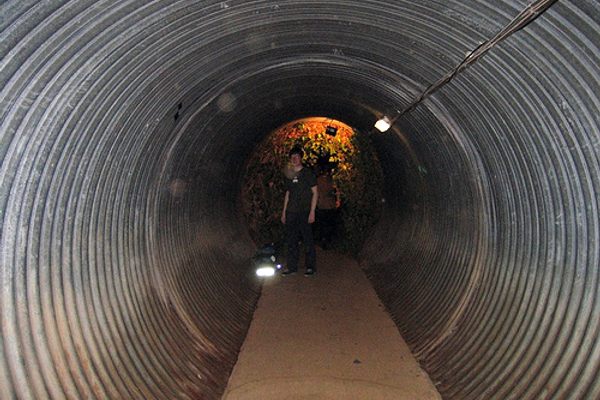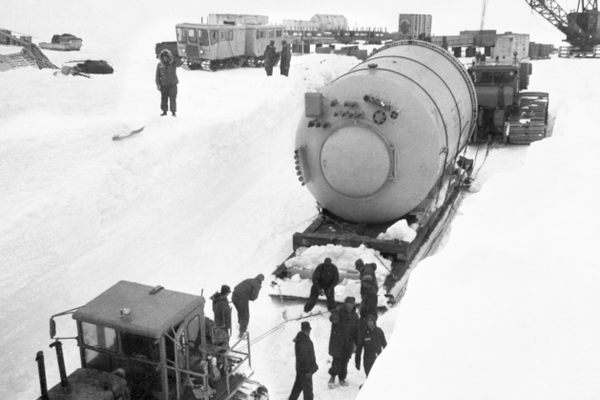The Architecture of Deceit
Camouflage: it’s not just for cuttlefish. From Paris to Los Angeles, many cities are home to secret structures that aren’t quite what they seem. The reasons span from the Cold War conflict to general urban beautification, but whatever the rationale, these fake facades are all pretty convincing.
Hiding in Plain Sight
Entrance to the Kelvedon Hatch Nuclear Bunker (photo by Genesisman26)
In a medieval farming village in Essex called Kelvedon Hatch, a structure that appears to be a single-family bungalow is actually the entrance to a nuclear bunker. Built in 1953, the bunker was intended as a possible regional government headquarters should the Russians decide to attack. Part of the elaborate ROTOR defense system, the bunker is entered through a 100-foot tunnel and extends 125 feet underground. It was well-equipped, with the capacity for a hundred people, and came with its own radio mast, A/C, and water supply. With the fall of the Soviet Union, the bunker was decommissioned and the land sold back to the family who owned it originally. They converted it into a museum, and today, it’s open for tours.
Stealthy Saltboxes
Disguised electric substation in Toronto (photo by Plainurban)
Starting in 1911, it was Toronto Hydro’s standard policy to build electrical substations in grand Edwardian style, so they resembled English estates more than utility buildings. But just before WWII, when building resources were starting to become less available, a colonial saltbox became Toronto Hydro’s de rigeuer substation incarnation, to match the general architectural styles of the neighborhoods. Some of the substations were even replete with shutters and white picket fences. About 45 of them remain standing today, some in formerly tony neighborhoods where the nicer homes have gone to seed; there, the utility buildings, well-maintained by the city all these years, stand out in sharp relief. Some have even been transformed into retail shops.
A few other cities practiced this art, although to a lesser degree. Raleigh, North Carolina, has a pumping station inside of a little neighborhood-looking house (if a little humbler than most of Toronto’s) that’s still standing at 3215 Wade Avenue, while Oyster Bay, New York, hides one in an adorable cottage. Manstique, Missouri and Virginia Beach, Virginia, have examples as well, in variously unassuming architectural styles.
The Listening Tree
Cell phone tower disguised to look like pine tree in Georgia (photo by Tom Spinker)
Examples of this kind of architectural subterfuge are everywhere, from South Africa to Portugal, and especially in the United States. Telecommunications companies have realized that nobody wants to look at their towers in all their naked glory, and plenty of people concerned about cancer risks don’t want phone towers in their neighborhoods and school zones.
So telecoms have gotten creative. There are lots and lots of fake saguaro cactus cell phone towers in California and Arizona, and various palm tree editions abound through the southern half of the U.S. Towers are frequently camouflaged as flagpoles too, a which is a brilliant ruse—it wouldn’t be very patriotic to second-guess someone who just wanted to fly the Stars and Stripes in your neighborhood.
The sneakiest trick, though, is the cell phone towers inside of existing church steeples. Both parties win here: the company gets their tower, and the church gets a little extra scratch by leasing the space. Dozens if not hundreds of churches do this, although when confronted, some claim to use the extra money for charity.
Sometimes they’re not even so slick: One weird wooden tower stands along I-5 just north of Seattle all by its lonesome, kind of a little triangular house on a stick (well, three sticks) and decorated with a Christian cross but not advertising any particular church or denomination. Upon researching, it’s just as we suspected: Shoreline Christian Church owns the property it’s built on and gave the telecom its blessing to build it, as long as they could disguise it any way they wanted.
Church-owned disguised cell phone tower in Seattle (photo by grossi)
Subway Subterfuge
58 Joralemon Street (photo by Matt Green)
This one seems to be the Internet’s favorite: On Joralemon Street in Brooklyn Heights, an 1847 Greek Revival townhouse stands in a row among more of the same, but this one has blacked-out windows and a very industrial door for a private home. Famously, it conceals a subway ventilator. The structure was a residence until it was procured in 1904 by the Interborough Rapid Transit Company, which operated the original New York City Subway; it was then outfitted with machinery guts in time for the subway system to open the same year. Of secret subway structures, this one is pretty well-known and loved, if only for how very incognito it is. Well, was. Once.
However, Paris sees Brooklyn’s tricky townhouse and raises it: On the grand Rue la Fayette that runs through Paris’s 9th and 10th arrondissement s, a dummy façade at number 145 contains a vent for the B line of the RER transit line. (This one was referenced in Umberto Eco’s Foucault’s Pendulum.) Around the corner, 174 rue du Faubourg Saint-Denis does the same, hiding a ventilation shaft for the Magenta Line, and the 2nd arrondissement has another shaft at 44 rue d’Aboukir.
145 rue la Fayette (photo by Geralix)
Oil up in Your Grill
Beverly Hills oil well (photo by Vaguely Artistic)
Los Angeles has seemingly gone the opposite route of everyone else with these strange triangle-shaped towers. You see them all over town, from Beverly Hills to West L.A., abutting a shopping mall or on the campus of a high school, decked out in festival murals and looking a little too sunny (and smokeless) to be smokestacks.
They’re oil wells. Active, functioning ones, sprinkled throughout the city and dolled up in floral print like they’re headed to Easter brunch. (To be fair, a few of them are actually concealed inside old office buildings, the usual way.) Los Angeles is the third-largest oil field in the country, in fact, although the city has very strict safety and noise regulations on the wells by this point and they’re not much of a danger to the townsfolk. Makes sense that they’ve got a system in place, seeing as people have been drilling in L.A. for over a century.
Whoever thought of this is a fracking (heh) genius; if you can’t hide it, just flaunt it. Click here to watch a fascinating documentary on the drilling that’s still going in L.A. now.









Follow us on Twitter to get the latest on the world's hidden wonders.
Like us on Facebook to get the latest on the world's hidden wonders.
Follow us on Twitter Like us on Facebook